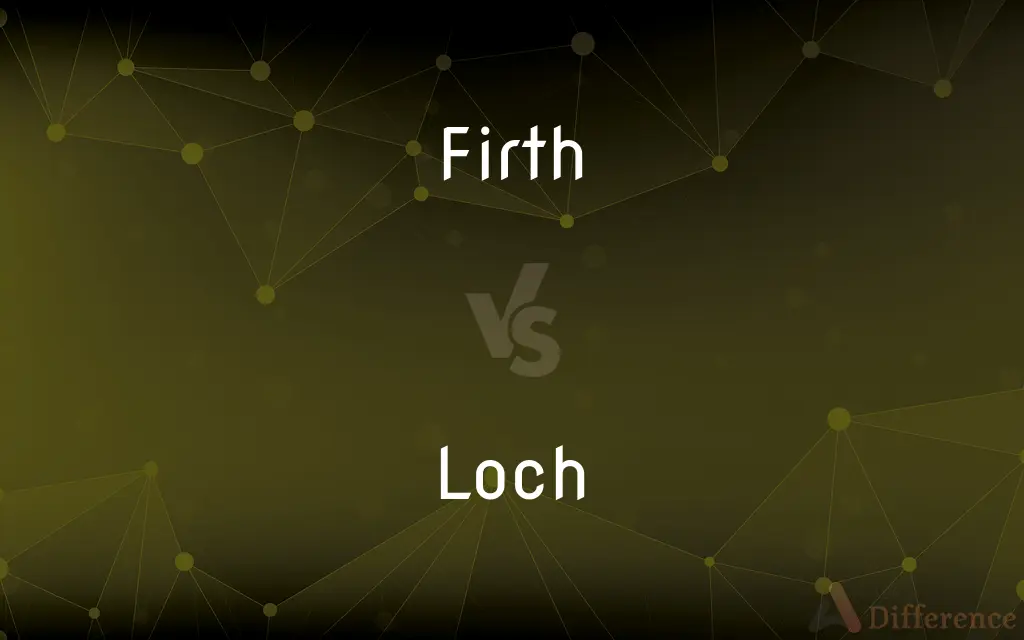Firth vs. Loch — What's the Difference?
By Maham Liaqat & Fiza Rafique — Updated on April 3, 2024
A firth is a long, narrow inlet of the sea, often the estuary of a river, while a loch is a Scottish term for a lake or a sea inlet, varying in size and shape.

Difference Between Firth and Loch
Table of Contents
ADVERTISEMENT
Key Differences
A firth refers specifically to a narrow inlet of the sea, frequently found in Scotland, and often describes estuaries of rivers as they meet the sea. On the other hand, a loch is a broader term used in Scotland to denote both freshwater lakes and sea inlets, making it a more inclusive term for various bodies of water.
Firths are typically characterized by their long, narrow shapes, and their formation is closely related to the geological and tidal processes at the mouths of rivers. In contrast, lochs can be either freshwater bodies located inland, resembling lakes, or saltwater inlets from the sea, which may or may not resemble the narrowness of firths.
The term "firth" is often used in place names to identify specific geographical features in Scotland, such as the Firth of Forth or the Firth of Clyde, highlighting significant estuarine areas. Lochs, meanwhile, are iconic features of the Scottish landscape, with famous examples including Loch Ness, known for its folklore, and Loch Lomond, noted for its natural beauty.
While both firths and lochs play important roles in Scotland's geography and culture, firths are primarily associated with the coastal regions and the interaction between rivers and the sea. Lochs are celebrated for their diversity, ranging from deep freshwater lakes nestled in mountainous regions to sea lochs that cut into the land from the coast.
The distinction between a firth and a loch lies not just in their physical characteristics but also in their cultural and historical significance. Firths have historically served as vital navigational and trade routes, whereas lochs have been central to local myths, legends, and the everyday life of the communities around them.
ADVERTISEMENT
Comparison Chart
Definition
A long, narrow inlet of the sea, often an estuary.
A Scottish term for a lake or a sea inlet.
Type
Mainly saltwater, connected to the sea.
Can be freshwater (lakes) or saltwater (sea inlets).
Shape
Typically long and narrow.
Varies widely from round lakes to narrow inlets.
Location
Coastal, at the mouth of rivers.
Can be inland (freshwater) or coastal (saltwater).
Examples
Firth of Forth, Firth of Clyde.
Loch Ness, Loch Lomond, Loch Fyne.
Cultural Significance
Important for navigation and trade.
Rich in folklore, beauty, and recreational significance.
Geological Formation
Formed by the drowning of river valleys and estuaries.
Formed by various geological processes, including glaciation.
Compare with Definitions
Firth
Coastal feature.
The castle overlooks the scenic firth, offering stunning views.
Loch
Scottish lake.
Loch Ness is famed for its mythical monster.
Firth
Long, narrow sea inlet.
The Firth of Forth is crossed by a remarkable rail bridge.
Loch
Varied in shape and size.
The small, round loch is a popular picnic spot.
Firth
Often an estuary.
Salmon fishing is popular in the estuarine waters of the firth.
Loch
Can be a sea inlet.
Loch Fyne is known for its excellent seafood.
Firth
Geological formation.
The firth was formed by the flooding of a river valley.
Loch
Cultural icon.
Legends of the loch have been told for generations.
Firth
Navigation route.
Ships navigate the firth to reach the inland port.
Loch
Fresh or saltwater.
Freshwater lochs are dotted throughout the Highlands.
Firth
Firth is a word in the English and Scots languages used to denote various coastal waters in the United Kingdom, predominantly within Scotland. In the Northern Isles, it more usually refers to a smaller inlet.
Loch
Loch () is the Irish, Scottish Gaelic and Scots word for a lake or for a sea inlet. It is cognate with the Manx lough, Cornish logh, and one of the Welsh words for lake, llwch.
Firth
A long, narrow inlet of the sea.
Loch
A lake.
Firth
An arm or inlet of the sea; a river estuary.
Loch
An arm of the sea similar to a fjord.
Firth
Alternative form of frith
Loch
A lake.
Firth
An arm of the sea; a frith.
Loch
A bay or arm of the sea.
Firth
English linguist who contributed to linguistic semantics and to prosodic phonology and who was noted for his insistence on studying both sound and meaning in context (1890-1960)
Loch
Alternative form of lohoch
Firth
A long narrow estuary (especially in Scotland)
Loch
A lake; a bay or arm of the sea.
Loch
A kind of medicine to be taken by licking with the tongue; a lambative; a lincture.
Loch
A long narrow inlet of the sea in Scotland (especially when it is nearly landlocked)
Loch
Scottish word for a lake
Common Curiosities
Are firths unique to Scotland?
While firths are characteristic of Scottish geography, similar geographical features can be found in other parts of the world but might not be called "firth."
What is a firth?
A firth is a long, narrow sea inlet, often at the mouth of a river.
How does a loch differ from a lake?
In Scotland, a loch is the term for both a lake and a sea inlet, not differing much from the general concept of a lake but including coastal inlets.
What is the significance of firths in Scottish history?
Firths have been crucial for navigation, trade, and defense throughout Scottish history.
Can a loch be both freshwater and saltwater?
Yes, lochs can be freshwater (inland lakes) or saltwater (coastal sea inlets).
How are firths and lochs represented in Scottish literature?
They are often depicted as dramatic settings, embodying the natural beauty and historical depth of Scotland.
Is Loch Ness a lake or a sea inlet?
Loch Ness is a freshwater lake, or loch, and does not connect to the sea.
Why are firths important for trade?
Their location at river mouths makes firths natural harbors and navigational routes for trade.
How do lochs affect Scotland's landscape?
Lochs, both freshwater and sea inlets, significantly shape Scotland’s varied and picturesque landscape.
How are firths formed?
Firths are typically formed by the drowning of river valleys due to sea level rise or land subsidence.
What role do lochs play in Scottish culture?
Lochs are deeply embedded in Scottish culture, known for their natural beauty, recreational use, and presence in myths and legends.
Can a firth be a loch?
Technically, a sea loch could be considered a type of firth, but the terms are usually used to distinguish between different types of water bodies.
Are there recreational activities common in both firths and lochs?
Yes, activities like boating, fishing, and sightseeing are popular in both firths and lochs, depending on their nature and location.
What makes firths and lochs significant for tourism?
Their stunning landscapes, recreational opportunities, and cultural significance make them key destinations for tourists visiting Scotland.
What's the difference in biodiversity between a firth and a loch?
Biodiversity can vary greatly, with saltwater firths supporting marine life and freshwater lochs hosting different freshwater species and ecosystems.
Share Your Discovery

Previous Comparison
Transresveratrol vs. Resveratrol
Next Comparison
Accumulate vs. CumulateAuthor Spotlight
Written by
Maham LiaqatCo-written by
Fiza RafiqueFiza Rafique is a skilled content writer at AskDifference.com, where she meticulously refines and enhances written pieces. Drawing from her vast editorial expertise, Fiza ensures clarity, accuracy, and precision in every article. Passionate about language, she continually seeks to elevate the quality of content for readers worldwide.
















































